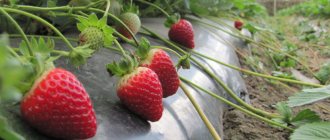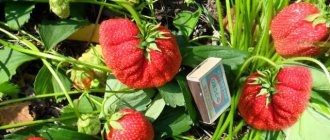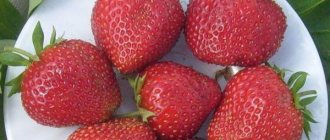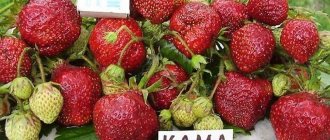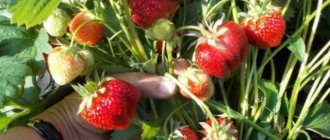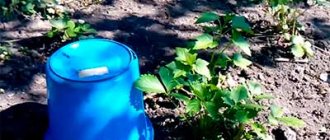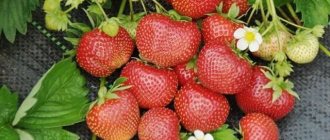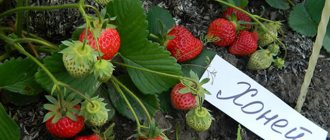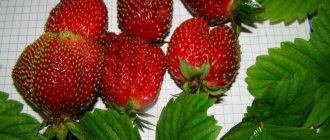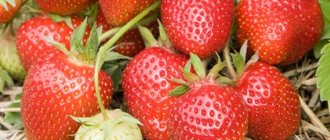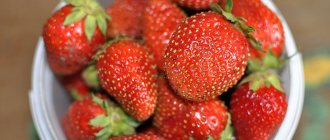Hello.
Please tell me how the Junia Smides strawberry differs from other varieties of these plants. They gave me several bushes, but I don’t know what to do with them. Some people praise Junia Smids, others criticize her, and most summer residents I know have no idea what it is. I don’t have time to wait for strawberries to show themselves in full glory. The experiments will take at least 2 years. And I need to know how to manage the strawberry beds. They are now empty, they urgently need to be filled with high-quality strawberries. I carefully looked through the information on the Internet. Opinions and characteristics differ significantly from each other. Some consider this variety to be high-yielding, while others do not share this opinion. The same discrepancies exist in the timing of fruiting. I would like to hear the opinion of experts and make a choice. Strawberry Junia Smides comes from the Baltic states. This variety was bred at the Latvian Institute of Agriculture. In Russia, it is officially recognized and included in the state register for the North-Western, Central, Volga-Vyatka and West Siberian regions. This means that Junia Smides strawberries can be legally and completely officially sold throughout the country.
Main characteristics of the variety:
- The berries are large in size. The average weight of the fruit is 30 g. The shape is symmetrical, blunt-conical, with a neck. The skin and flesh are red. Taste: aromatic and tender pulp with a sweet and sour taste. When ripe, the fruit hangs for a long time, up to 3 days, without rotting. Flowers and fruits are placed under the leaves, making them unnoticeable to birds. At the beginning of the fruiting period, the berries are large, then they become smaller, but not significantly. This variety is characterized by the presence of a dense skin, which allows the fruits to be transported over long distances, as well as stored refrigerated for up to 5 days.
- The bush is powerful, semi-spreading. The number of rosettes is average, the flower stalks also fit within the statistical average.
- The variety is resistant to diseases and pest damage. It has average resistance to powdery mildew and wilt, and is not affected by gray rot. However, this only applies to small organisms. The berries are eaten with pleasure by mice, birds, and insects, which is proof of their good taste.
- The official description of the Junia Smides variety states its high yield. Reviews of a different nature may be associated with the degeneration of the variety in a given area due to improper pollination or loss of soil fertility. In addition, low yields are often characteristic of too young plantings, when the root system of the bushes has not yet developed sufficiently.
- It has high tolerance to both temperature and humidity. This does not mean that during severe winters, the plantings of Junia Smids strawberries do not need to be covered. However, under film and snow, it overwinters well and renews itself beautifully in the spring. It can go for a long time without watering, but it cannot stand drying out, like all the plants of this group.
Here she is, strawberry Junia Smides. Decide for yourself whether to plant it or not, but since you have several bushes, you can plant a whole bed. This is a good variety with unique qualities.
Strawberries Junia Smides are very popular among Russian gardeners: they are sweet and aromatic. Each variety requires certain conditions and this one is no exception. Before planting, you should study the nuances of care.
Description of the variety and photo
The variety was bred in Latvia and is one of the sweetest and juiciest. The plant is resistant to most diseases. However, the beautiful, bright red berries attract the attention of insects, birds and mice, who happily eat them. Gardeners need to be very careful and take certain measures to repel pests.
Bush of this variety:
- powerful;
- semi-spreading;
- gives an average number of sockets.
Ripening time is average. The variety is excellent for growing in central Russia and the northern regions. The plant copes with spring frosts, but may not withstand winter frosts, so it is covered in winter.
Description of the variety
Junia Smids is an early ripening strawberry. According to the entry in the state register, it is recommended for cultivation in the North-Western and Volga-Vyatka regions. It is characterized by high yield, good disease resistance and high winter hardiness. Disadvantages include the smaller size of the berries (only the first fruits are large).
Bushes
Junia smids bushes are powerful, beautiful, semi-spreading. Thick peduncles are located just below the bright green foliage, so the berries are hardly noticeable to birds and are not baked in the sun. The formation ability is average.
Berries
The variety cannot be classified as large-fruited. The average weight of a ripe berry of the first wave is about 30 g, subsequent waves of fruiting are much smaller. The shape of the fruit is blunt-conical, with a neck. The skin is dense, red. The pulp is juicy, aromatic, there are no voids even in the largest specimens. The taste is excellent. The sweetness is amazing, without cloying, with a subtle sourness.
Fully ripened fruits of Junia Smids can remain on the bushes for up to 3 days without loss of commercial quality.
Productivity
The variety reveals its high potential only in the third year, when a powerful root system develops. If strawberries are given attention and agrotechnical recommendations are followed, Junia Smids will be pleased with the yield. Not every variety can boast a yield of up to 1.0 kg. berries from the bush. The thick skin allows the fruit to be transported over long distances.
The delicious fruits are used to make jams and sweet desserts. Children really like fresh strawberries. When refrigerated, fruits can be stored for up to 5 days.
Characteristics of the berry
Strawberries of this variety are large in size. The fruits can weigh 30-35 g . They are symmetrical and conical in shape.
The following characteristics stand out in particular:
- the skin and flesh are red;
- the berries taste sweet, but not cloying;
- It has an incredible aroma that attracts everyone.
The ripe fruit can hang on the bush for up to three days and remain fresh. The skin is quite dense, so many pests cannot bite through it and get to the pulp. can be transported over long distances without losing their shape.
Features of strawberry Junia Smides
Hello. Please tell me how the Junia Smides strawberry differs from other varieties of these plants. They gave me several bushes, but I don’t know what to do with them. Some people praise Junia Smids, others criticize her, and most summer residents I know have no idea what it is. I don’t have time to wait for strawberries to show themselves in full glory. The experiments will take at least 2 years. And I need to know how to manage the strawberry beds. They are now empty, they urgently need to be filled with high-quality strawberries. I carefully looked through the information on the Internet. Opinions and characteristics differ significantly from each other. Some consider this variety to be high-yielding, while others do not share this opinion. The same discrepancies exist in the timing of fruiting. I would like to hear the opinion of experts and make a choice.
Strawberry Junia Smides comes from the Baltic states. This variety was bred at the Latvian Institute of Agriculture. In Russia, it is officially recognized and included in the state register for the North-Western, Central, Volga-Vyatka and West Siberian regions. This means that Junia Smides strawberries can be legally and completely officially sold throughout the country.
Main characteristics of the variety:
- The berries are large in size. The average weight of the fruit is 30 g. The shape is symmetrical, blunt-conical, with a neck. The skin and flesh are red. Taste: aromatic and tender pulp with a sweet and sour taste. When ripe, the fruit hangs for a long time, up to 3 days, without rotting. Flowers and fruits are placed under the leaves, making them unnoticeable to birds. At the beginning of the fruiting period, the berries are large, then they become smaller, but not significantly. This variety is characterized by the presence of a dense skin, which allows the fruits to be transported over long distances, as well as stored refrigerated for up to 5 days.
- The bush is powerful, semi-spreading. The number of rosettes is average, the flower stalks also fit within the statistical average.
- The variety is resistant to diseases and pest damage. It has average resistance to powdery mildew and wilt, and is not affected by gray rot. However, this only applies to small organisms. The berries are eaten with pleasure by mice, birds, and insects, which is proof of their good taste.
- The official description of the Junia Smides variety states its high yield. Reviews of a different nature may be associated with the degeneration of the variety in a given area due to improper pollination or loss of soil fertility. In addition, low yields are often characteristic of too young plantings, when the root system of the bushes has not yet developed sufficiently.
- It has high tolerance to both temperature and humidity. This does not mean that during severe winters, the plantings of Junia Smids strawberries do not need to be covered. However, under film and snow, it overwinters well and renews itself beautifully in the spring. It can go for a long time without watering, but it cannot stand drying out, like all the plants of this group.
Here she is, strawberry Junia Smides. Decide for yourself whether to plant it or not, but since you have several bushes, you can plant a whole bed. This is a good variety with unique qualities.
Landing
Before planting, you should choose a suitable location. The area should be well lit and there should be no other plants or bushes nearby. Otherwise, it will not take root and the harvest will be meager. Crops such as peppers, tomatoes, eggplant, and potatoes are especially destructive They shouldn't be around.
Only when a suitable site has been found can planting begin.
This process has the following features:
- the distance between bushes should be 30-35 cm;
- between rows varies from 40 to 50 cm;
- It’s excellent if the soil on the site is slightly acidic - it is well suited for such strawberries.
Recommendations for planting Junia Smides
First, before planting, you should choose the right site. There should be enough sunlight and heat on the site. In addition, there should be no other bushes on it that could interfere with the growth and development of garden strawberries. It is especially important to ensure that there are no peppers, potatoes, cucumbers or eggplants near the Junia Smides strawberries. The most pleasant predecessors and neighbors will be dill, parsley, and marigolds. After finding the most suitable area for planting, you can begin the process. Which has the following recommendations:
- It is worth maintaining a distance between bushes of up to 35 cm; Junia Smides loves spacious places;
- the number of centimeters between rows should be increased to 45. If the size of the plot allows, you can take away the entire 50 cm for the distance;
- The strawberry variety Junia Smides responds very well to slightly acidic soil.
When working with strawberry rosettes, you must be extremely careful, otherwise they can easily be damaged. After planting, they must be gently covered with soil. And then pour plenty of water, but in such a way as to prevent flooding. But you shouldn’t forget to water the berries. Due to lack of moisture, it may dry out.
Care and feeding
Care includes:
- regular watering;
- weed removal;
- mulching;
- feeding
As soon as weeds appear in the soil, they are immediately gotten rid of, the soil is lightly loosened and mulched. Mulching should be done every 7-10 days .
The plant needs feeding in the spring. Horse humus or humus is used as fertilizing. Horse humus is taken in the amount of 5 kg per square meter. Humus is taken in the amount of 7 kg per square meter. You can also use mullein. It is diluted with water in a ratio of 1:4.
Feed the plant once every 10 days until berries form. These measures will help the plant stay healthy and produce a rich, tasty harvest.
Diseases and pests
It is rarely affected, but with insufficient care, the occurrence of diseases is quite possible. The most common diseases are:
Mice, slugs, and insects that are attracted to bright red fruits can cause harm. To repel pests, you should use onion solution. To do this, use 200 g of onion peels and a bucket of water . The components are mixed and infused for several days. After this, the solution is sprayed on the soil and bushes.
Calendula solution will also help . Combine a bucket of water and 4-5 spoons of dry plant. Leave for several hours, and then spray the soil and bushes with it. Slugs should be fought with sand and ash. Sand is poured under the bushes, and ash is poured on top of this sand.
Growing and care
The Junia Smids strawberry is responsive to good care and will reward a caring gardener with a generous harvest.
Watering
When young seedlings adapt, watering is done 2 times a week; the first week after planting, daily watering is necessary. On rainy days they take a break. The seedlings will not like stagnant moisture; you need to focus on the condition of the soil. An excellent solution for caring for this variety would be to organize drip irrigation.
The following rule applies to strawberries Junia Smids: watering is moderate but regular.
Loosening, weed control
Weeds should not be allowed to thrive in strawberry beds. You need to get rid of them immediately and lightly loosen the soil. You can mulch the beds, then this process will go easier. Straw, leaf litter, sawdust, peat, and non-woven material are suitable as mulch. It must be remembered that organic mulch binds soil nitrogen, so it is advisable to spill it with a solution of mullein (1:10) or bird droppings (1:20).
Removing a mustache
The tendrils that strawberry bushes periodically throw out must be removed in time. If this is not done, the young rosettes will take strength from the bush and this will affect the yield. Since the variety is not prone to thickening, the gardener will not have to carry out this procedure very often.
Top dressing
Regular feeding is an important point in caring for the Junia Smids strawberry variety.
It is best to use horse and cow humus. About 7-10 kg will be required per square meter of planting each year. organics. Liquid fertilizing is carried out 3-4 times, starting in early spring until the berries form. Feeding at this time will allow you to get a good strawberry harvest.
Another option is to make a nettle infusion. The third part of the container is loaded with cut nettles and filled with water. After 4-5 days you can feed the strawberries. The tops are used as mulch, and the water nettle infusion is diluted 1:3. A bush needs 1 liter of fertilizer.
Strawberries respond well to foliar feeding with ready-made mineral complexes, for example, Plantafol.
Pest and disease control
Junia Smids is rarely affected by diseases. These strawberries can be grown without the use of chemicals if the requirements for soil moisture and acidity are met. For preventive purposes, folk remedies or prophylactic drugs are used, for example, Fitosporin or Fitoverm.
During prolonged rains, strawberries are sprayed with a pink solution of manganese, which dries the bushes and prevents mold from growing. Potassium permanganate also acts as an excellent foliar feeding.
The plant must be protected from mice, slugs, and numerous insects that are attracted to sweet fruits. To combat slugs, you can use sand and ash, which are sprinkled layer by layer under the bushes.
To repel pests, use onion peels. Boil a glass of husk in 1 liter of water for 5-10 minutes. Pour the resulting broth into a bucket and add 8-9 liters of water. In the evening, the beds are treated with the solution. This treatment is also disease prevention. Similarly, a solution is prepared from calendula flowers and tops.
Preparing for winter
The variety can be grown in central Russia and in the northern regions with the condition of shelter for the winter. Before sending strawberries for the winter, you need to clean the bed of weeds and dry leaves. Straw, sawdust, foliage, pine needles, and spunbond are used for shelter. The best protection against freezing is a thick layer of snow cover.
You cannot use plastic film as a covering material for strawberry beds. During thaws, condensation can provoke mold and death of the bush.
Reviews from gardeners
Maria, 38 years old: “I’ve been familiar with this variety for a very long time. A friend recommended him to me, I decided to listen to her and hired Junia Smides. At first I was afraid of ruining everything, I carefully monitored the health of the plant, but it turned out that caring for it was not so difficult. As a result, my labors were rewarded with a rich harvest. Since then I have planted every year and have no regrets! The taste is incredible, and the smell is felt as soon as it begins to ripen. Highly recommend if you choose a sweet variety of strawberries.”
Alina, 45: “My sister recommended this variety to me. She loves it, I have tried it several times both fresh and in the form of jam. I liked it so much that I decided to plant it myself! In fact, planting and growing are not difficult; all you need to do is be an attentive gardener, remove weeds and water them on time. The time will come, it will ripen and delight you with delicious berries! The plant did not get sick, but for this purpose I often fed it and repelled pests with the help of a calendula solution. It helped, the solution turned out to be effective! I recommend strawberries to everyone.”
Yana, 32 years old: “This variety attracted me immediately when I read about it on the Internet. I wanted to grow it in my own garden bed. As a result, I planted it, grew it, and made delicious jam from the collected berries. The berries really ripened exactly as experts described them on the Internet. You will like it: the berries are juicy and sweet! You will not regret! At first, of course, it can be a little scary; it seems that the plant needs a lot of attention. But in fact, it is not capricious and does not require too much care. The main thing is to water it on time, since drought is destructive.”
It is no coincidence that the Junia Smides strawberry is one of the most popular on the market: it is juicy, sweet and aromatic. Having learned the peculiarities of growing this variety, the gardener will be able to grow it in his garden.
Garden plant diseases
The variety Junia Smides is rarely affected by any garden diseases. This situation can arise, perhaps, due to illiterate care of the plant. The most common diseases are:
- powdery mildew;
- wilt disease;
- fungal infection of shrubs.
Strawberries also attract a number of other garden pests such as mice and slugs. Folk remedies recommend using onion solution to repel pests. One bucket of clean water for the solution will require 200 grams of onion peels. The ingredients need to be mixed together and left for several days. Once ready, it is used as a method of spraying the soil of the berries against pests.
Another method of neutralizing pests is calendula infusion. A bucket of water will require 5 tablespoons of dried herbs. You need to leave it for several hours; many recommend leaving it overnight. After which you can also spray the soil with it. Unlike onions, the risk of corroding roots and bushes in case of abuse is minimized.
With proper care of the Junia Smides variety, you can get a tasty, high-quality and aromatic harvest.
Video
Watch this video - it will help you choose:
The only thing better than strawberries is wild strawberries! This is probably why this berry is so popular in Russian gardens. Today, even residents of high-rise buildings grow strawberries, because there are many varieties intended for planting in pots or boxes. Strawberries have a lot of advantages, but the main trump cards of this berry are the sweet taste and aroma that personify summer.
Read also: How to plant an apple seed at home
What qualities of strawberries are most valued by summer residents, and which variety to choose for planting on your plot - this is what the article is about.
What is the value of the strawberry variety?
Every gardener who has been growing sweet berries for many years probably already has a couple of favorite varieties. And you can love strawberries for various reasons: some people like the sweet variety of strawberries, some put the berry’s yield first, while others even prefer exclusive varieties that stand out from the general background due to the size of the berries or their exotic taste.
Feedback from experienced gardeners made it possible to rank the most important requirements put forward by farmers for sweet berries:
- Strawberries should be large. The berry's mass is within 50-60 grams and can be called such. Such sizes of strawberries ensure high yields, because up to a kilogram of fruit can be harvested from each large-fruited bush. And such a berry looks very presentable, they will definitely want to buy it (this question usually concerns summer residents who grow fruit for sale).
- To preserve their presentation for a long time, strawberries must have a dense consistency. Such berries are unlikely to become prey to slugs or become infected with rot, they will not be crushed during transportation and will look great as decoration.
- Productivity has always been a fundamental factor when choosing a variety of any garden crop. Only true connoisseurs of the exclusive taste or unusual appearance of berries may not be concerned about the issue of profitability. Other gardeners prefer productive varieties, which allow a couple of rows of strawberries not only to fill them with fresh fruits, but also to stock up on something for the winter.
- Variety resistance is no less important. Preferred varieties are those that can withstand winter frosts, intense heat, and periods of drought. It would be nice if the strawberries chosen for a summer cottage are undemanding to the composition of the soil and do not require complex care or regular fertilizing. The variety's resistance to diseases and pests is especially appreciated. And most importantly, along with all this, the berry should be tasty and productive.
- The taste and aroma of strawberries are probably the most important factors that should guide you when choosing a variety. In order for the berry to smell pleasant and taste good, it must maintain a balance of acids and sugars. Such strawberries will not only be delicious, but also the healthiest.
The best and sweetest varieties of strawberries
It is not often that strawberry seedlings are found on sale that meet all five parameters of a quality fruit. Even the most elite varieties score a maximum of 90% of one hundred possible evaluation points: it is impossible to create the ideal berry that meets the requirements of all gardeners.
However, from all the variety of varieties and varieties, it is still possible to select the best ones: differing in size, durability or sweetness.
After all, a gardener will be able to harvest from such bushes three to four times a year. But to do this, you will have to carefully care for the strawberries: plant bushes, regularly fertilize the soil and water the beds abundantly.
"Avis Delight"
An excellent variety that meets several requirements of farmers:
- strawberries are very productive - from each bush, with good care, the farmer will receive about three kilograms of fresh berries;
- tolerates difficult climates, possible frosts and pest attacks;
- the berries are very sweet and have a strong strawberry aroma;
- The presentation of the fruit is also excellent - the strawberries are smooth, shiny, and large.
Seedlings of such strawberries should first of all be purchased by summer residents from the northern regions of the country, because the Evis Delight variety is not afraid of cold and high humidity.
"Shelf"
This strawberry is suitable for true connoisseurs of sweet berries, because the variety has a delicate taste and a very strong aroma. Even not quite ripe Polka berries smell great and contain a lot of sugar, this allows you to harvest while the fruits are dense and transport strawberries over long distances.
Growing the variety is quite simple, because “Polka” does not need fertile soils or special conditions; it feels great in an ordinary dacha and is able to cope with difficult climates and dangerous insects.
In addition to all of the above, strawberries of this variety are also high-yielding.
"Pineapple"
These berries will delight those who love non-traditional tastes and aromas of fruits. The whitish strawberries are not very large in size, have thin skin and very tender pulp. The taste of Pineapple strawberries is practically no different from traditional varieties, but the aroma of the berries is very exotic.
The variety should be grown in open areas of the garden, well lit by the sun, with normal ventilation. If these requirements are not followed, the delicate berries may be affected by gray rot or their taste may be enjoyed by slugs.
Read also: Buy gladioli in Moscow inexpensively
It is recommended to consume this variety only fresh, so a few exotic bushes will be quite enough for the average summer resident.
"Junia Smides"
This is a strawberry with an average ripening period, so it is suitable for growing in the middle zone and in the north, where there is a high probability of May frosts, which occur during the flowering period of early varieties. But, if the berry can cope with spring frosts, then too low temperatures in winter can be destructive for strawberries - the variety needs winter shelter.
Junia Smides berries are very tasty, with a strong aroma. The consistency of the fruits is quite dense, which allows them to be used for preservation as a whole or for sale.
The berry is not afraid of pests; the thick peel makes the pulp inaccessible to most of them. A distinctive feature of the variety is its very high yield, because a farmer can collect about two kilograms of fruit from each bush.
"Onega"
This strawberry was developed quite recently, but it has already gained considerable popularity among Russians. Gardeners value the variety for its high yield, remarkable ability to withstand bad weather conditions and cold, resistance to pests and immunity against most “strawberry” diseases.
The taste of the berries is quite traditional - sweet and sour, moderately rich aroma. In addition, the fruits can be transported and used for industrial purposes; they are dense and beautiful.
"Chamora Turussi"
Strawberry variety bred in Japan. A distinctive feature of the berries is their enormous size, because each strawberry can weigh about 100 grams. In one season, a gardener can harvest up to three kilograms of an excellent harvest from each bush.
However, not only the appearance of “Chamora Turussi” attracts domestic farmers, this strawberry is very tasty, and its aroma resembles the smell of wild strawberries.
With each season, the berries will become smaller, but will still remain large enough and retain their taste.
"Primella"
This strawberry belongs to the Dutch selection. The variety is considered mid-season, and therefore is excellent for growing throughout most of Russia.
Primella berries are quite large; their weight in the first year can exceed 70 grams. But the variety is famous not for its size, but for its individual characteristics of taste and aroma: these strawberries taste like pineapple, while the fruits smell like strawberries.
If you care for the bushes correctly, strawberries of this variety will be able to bear fruit in one place for about 5-6 years, after which the bushes need to be replanted. The variety is not afraid of pests and is hardened against most diseases and viruses. Strawberries are considered very productive.
"Kimberly"
For those who live in the south of the country or grow strawberries in protected ground, early-ripening varieties are considered more suitable, allowing them to harvest sweet berries in the first half of June.
One of these varieties is "Kimberly". The berries grow large, have fairly dense pulp, so they tolerate transportation well and can be used for industrial purposes.
Strawberries have an excellent taste, and this is not surprising, because it is considered one of the record holders for the sugar content in berries. Another advantage of the variety is winter hardiness. Even severe frosts are not dangerous for Kimberly bushes; strawberries do not need to be covered for the winter.
Review of strawberries "Kimberly"
This variety can boast that it satisfies almost all the requirements of farmers:
- gives high and stable yields;
- able to grow in unstable, harsh climates;
- resists diseases and is not attacked by pests;
- has large and beautiful berries;
- It has a pleasant sweet taste and strong aroma.
The fruits of the "Tago" variety are excellent for whole-fruit canning and the preparation of canned compotes. These strawberries are often used to decorate desserts.
"Chelsea Pensioner"
In Russia, strawberries of this type began to be grown relatively recently, but this did not prevent the variety from becoming one of the most popular in domestic summer cottages and vegetable gardens.
The advantages of Chelsea Pensioner are its excellent aroma and good taste, harmoniously combined with suitability for transportation and storage.
The fruits do not ripen at the same time - the owner can enjoy fresh berries at any time during the summer season.
Do not forget about watering the bushes, because a lack of moisture will certainly affect the taste of the berries.
